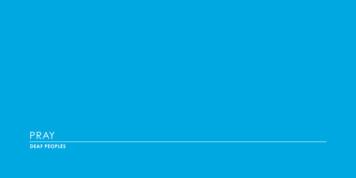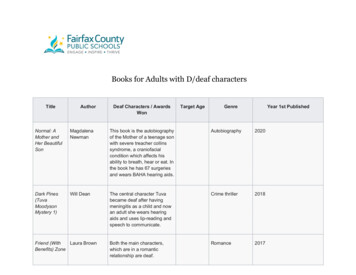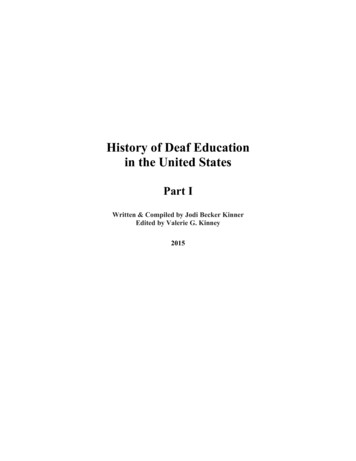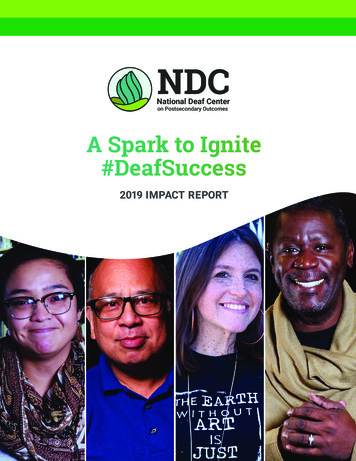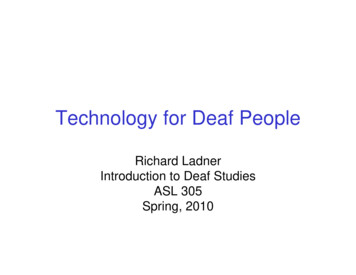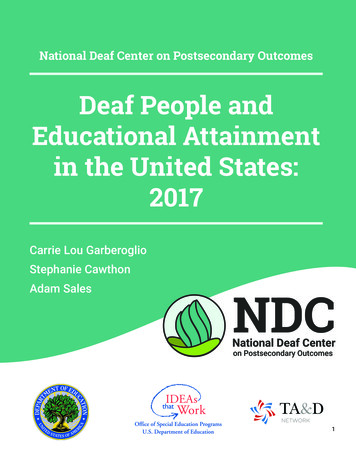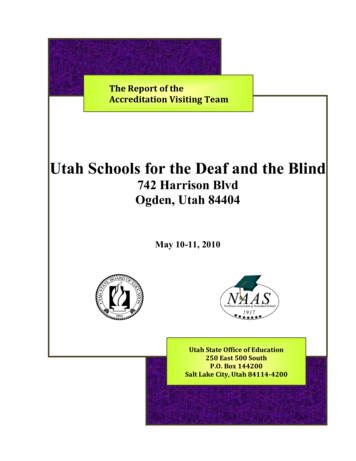
Transcription
The Report of the Accreditation Visiting Team Utah Schools for the Deaf and the Blind742 Harrison BlvdOgden, Utah 84404May 10-11, 2010Utah State Office of Education 250 East 500 South P.O. Box 144200 Salt Lake City, Utah 84114Ǧ4200
THE REPORT OF THEVISITING TEAM REVIEWINGUtah Schools for the Deaf and the Blind742 Harrison BlvdOgden, Utah 84404May 10-11, 2010UTAH STATE OFFICE OF EDUCATIONLarry K. Shumway, Ed.D.State Superintendent of Public InstructionDIVISION OFSTUDENT ACHIEVEMENT AND SCHOOL SUCCESSBrenda Hales, Associate SuperintendentLynne Greenwood, DirectorCurriculum and InstructionGerolynn Hargrove, CoordinatorCurriculum and InstructionGeorgia Loutensock, Accreditation SpecialistCurriculum and InstructionSalt Lake City, Utah
TABLE OF CONTENTSForeword . iiUtah State Board of Education. iiiUtah Schools for the Deaf and the Blind Advisory Council and Administration . 1Utah Schools for the Deaf and the Blind Mission Statement, Belief Statements, andDRSLs . . 2Members of the Visiting Team . 3Visiting Team Report . 4Chapter 1: School Profile . 4Suggested Areas for Further Inquiry . . 5Chapter 2: Northwest Association of Accredited Schools (NAAS)Teaching and Learning Standards . 6Mission, Beliefs and Desired Results for Student Learning (DRSLs) . 6Curriculum . 7Instruction . 7Assessment . 9Chapter 3: NAAS Support Standards. 10Leadership and Organization . 10School Services . 11Facilities and Finances . 11Chapter 4: NAAS School Improvement Standard . 12Chapter 5: Community Building . 13Chapter 6: Major Commendations and Recommendations of the Visiting Team . 14i
FOREWORDThe purpose of the accreditation process is to stimulate school growth and improvement soas to increase the quality of instruction and student achievement. In these efforts, the schoolstaff makes a comprehensive evaluation of the school’s programs, operations, and results.The school determines how actual practices align to stated objectives and resultingoutcomes in a three-step evaluation: (1) self-evaluation, (2) on-site evaluation by anexternal team of educators, and (3) implementation using units of the evaluation to improvethe school by effecting thoughtful change.The evaluation, May 10-11, 2010, was conducted because of the school’s desire to ensurequality education for all students in the school, and to increase student achievement.The entire staff of Utah Schools for the Deaf and the Blind is commended for the time andeffort devoted to studying and evaluating the various facets of the total program and topreparing the materials used by the Visiting Team. The excellent leadership given bySuperintendent Steven W. Noyce is also commended.The staff and administration are congratulated for their desire for excellence at UtahSchools for the Deaf and the Blind and for their professional attitude which made itpossible for them to see weaknesses and strengths and to suggest procedures forimprovements.While these recommendations may be used to solicit financial support to acquire some ofthe materials, equipment, and services needed to carry out a more effective program, it ismost important that the faculty and administration utilize them as they continue to evaluateand modify course offerings and administrative and classroom procedures to moredramatically increase student achievement at Utah Schools for the Deaf and the Blind.Larry K. Shumway, Ed.D.State Superintendentof Public Instructionii
UTAH STATE BOARD OF EDUCATION250 East 500 SouthP. O. Box 144200Salt Lake City, UT 84114-4200District 1Tami W. Pyfer52 Ballard WayLogan, UT 84321Phone: (435) 753-7529District 6Michael G. Jensen4139 S Aubrey Ln.West Valley City, UT 84128Phone: (801) 968-5960District 11David L. Crandall13464 Saddle Ridge DriveDraper, UT 84020Phone: (801) 501-9095District 2Greg W. Haws5841 West 4600 SouthHooper, UT 84315Phone: (801) 985-7980District 7Leslie B. Castle2465 St. Mary’s DriveSalt Lake City, UT 84108Phone: (801) 581-9752District 12Carol Murphy463 West 140 NorthMidway, UT 84049Phone: (435) 729-0941District 3Craig E Coleman621 South Main St.Genola, UT 84655Phone: (801) 754-3655District 8Janet A. Cannon5256 Holladay Blvd.Salt Lake City, UT 84117Phone: (801) 272-3516District 13C. Mark Openshaw3329 Piute DriveProvo, UT 84604Phone: (801)377-0790District 4David L. Thomas7875 South 2250 EastSouth Weber, UT 84405Phone: (801) 479-7479District 9Denis R. Morrill6016 South 2200 WestTaylorsville, UT 84118Phone: (801) 969-2334District 14Dixie Allen218 West 5250 NorthVernal, UT 84078Phone: (435) 789-0534District 5Kim R. Burningham932 Canyon Crest DriveBountiful, UT 84010Phone: (801) 292-9261District 10Laurel Brown5311 South Lucky Clover Ln.Murray, UT 84123Phone: (801) 261-4221District 15Debra G. RobertsBox 1780Beaver, UT 84713Phone: (435) 438-5843Meghan Holbrook*775 North Hilltop RoadSalt Lake City, UT 84103Phone: (801) 539-0622Rosanita Cespedes*1470 S 400 ESalt Lake City, UT 84115Phone: (801) 466-7371Charlene Lui**766 N 900 WOrem, UT 84057Phone: (801)230-5109Douglas J. Holmes***274½ 25th StreetOgden UT 84401Phone: (801) 479-8163Larry K. ShumwayExecutive OfficerTwila B. AffleckSecretary*Board of Regents Appointments** CMAC Representative Appointmentiii***UCAT Representative7/22/2009
UTAH SCHOOLS FOR THE DEAF AND THE BLINDADVISORY COUNCILVon Hortin . Council ChairGwyneth Kenner . Council Vice-ChairLinda Braithwaite. Council MemberMarilyn Call . Council MemberLeslie Castle . Council MemberAmy English . Council MemberScot Ferre . Council MemberRon Gardner . Council MemberBill Gibson . Council MemberJodi Kinner . Council MemberKye Miner . Council MemberLinda Otte . Council MemberMichelle Tanner . Council MemberUTAH SCHOOLS FOR THE DEAF AND THE BLINDADMINISTRATIONSteven W. Noyce . SuperintendentMichael Sears . Financial DirectorMelanie S. Austin. Associate Superintendent of the BlindJennifer Johnson Howell . Associate Superintendent of the DeafHollie Fletcher .Educational Resource Center DirectorLeah Voorhies . Related Services DirectorCarolyn Lasater .USB Region I DirectorKim Morris. USB Parent Infant Program DirectorLee Weaver . USB Region II DirectorLeslie Buchanan . Deafblind Services DirectorDay Mullings . USD Parent Infant Program DirectorJill Radford. USD Jean Massieu School DirectorLiz Parker . USD Central Region DirectorMarilyn Madsen . USD South Region DirectorTrena Roueche . USD North Region Director-1-
UTAH SCHOOLS FOR THE DEAF AND THE BLINDMISSION STATEMENTThe Utah School for the Deaf and the Blind leads the way in providing a caring,responsive, innovative approach to meet the education needs of our low incidencepopulation.BELIEF STATEMENTSxEach student is a valued individual with unique physical, social, emotional andintellectual needs.xStudents learn in different ways and should be provided with a variety of instructionalapproaches to support their learning and growth.xStudents learn best when they are actively engaged in the learning process.xA student’s self-esteem is enhanced by positive relationships and mutual respect withstaff, students and their families.xCurriculum and instructional practices should incorporate a variety of learningactivities.xStudents learn best when they have appropriate opportunities for success in school,home and community.DESIRED RESULTS FOR STUDENT LEARNING (DRSLs)Every USDB student will use multiple avenues for communication.x Students will use various strategies for effective communication (read, write,speak, sign, body language, augmentative communication).x Students will respond to communication from others.x Students will engage in academic and social interactions with others usingcommunications skills.Every USDB student will access the Utah Core Curriculum.x Students will participate in age appropriate class groups.x Students will engage in Expanded Core Curriculum activities.x Students will explore grade level concepts.x Students will demonstrate understanding of elements of the Utah CoreCurriculum.Date of Visit: May 11-12, 2010-2-
MEMBERS OF THE VISITING TEAMSteven K. Hirase, District Office, Murray School District, Visiting TeamChairpersonKelli Kercher, Horizon Elementary School, Murray School DistrictGeorgia Loutensock, Utah State Office of EducationRob Stillwell, Accreditation Consultant, Utah State Office of Education-3-
VISITING TEAM REPORTUTAH SCHOOLS FOR THE DEAF AND THE BLINDCHAPTER 1: SCHOOL PROFILEUtah Schools for the Deaf and the Blind (USDB) began in 1884 with the formation of theSchool for the Deaf. The school was created with a message from Governor Eli Murrayto the Territorial Legislature. Services were started with one deaf student on the OldDeseret Campus, now the University of Utah.The School for the Blind was established in 1896, as Utah gained statehood. At the sametime, 57 acres of land was dedicated at the old Territorial Reform School, where theschools would eventually be built. In the beginning the two schools had separatecampuses, both located in Ogden. the School for the Deaf was located on 24th Street andthe School for the Blind was on Harrison Boulevard. Both institutions were residentialsettings and were self-sufficient, providing both educational and life skills training forstudents.In the beginning, students arrived at school in the fall of the new school year and did notreturn home until the end of that school year. Students were eligible to attend the schoolsif they were at least eight years old and had documented deafness or blindness. Historicalaccounts of the school confirm that this was a very lonely time for many students. Eventhough the school staff worked hard to create a homelike atmosphere, students feltstrongly the loss of their home and family experiences.After a time, it became clear that the students and families of this state prefer not toreceive services in a residential setting. During the years of special education reform inthe 1970s, USDB services changed to reflect new national attitudes. With the passage ofPublic Law 94-142, opportunities for educational services closer to home became areality for many families. The USDB residential program became smaller and smaller asservices were offered in a greater variety of locations throughout the state.Today, residential services are provided for only 28 students during the school week,with each student returning to his/her home on weekends and holidays. As a result of thisdeclining enrollment in the residential program, USDB is reconfiguring servicesbeginning in the 2010-11 school year to meet the needs of students who require intensivevocational and life skills instruction in order to live independently.a)What significant findings were revealed by the school's analysis of its profile?The Visiting Team, through its analysis of the school’s profile, observations, andinterviews with staff, students, and patrons, found the following things:-4-
xxxxxb)A high level of commitment to students among staff membersFocus as faculty on individual student achievement based on students’unique needsProvision of deaf and blind students within the state of Utah with a fullcontinuum of services, through a service model including earlyintervention programs, center-based programs, magnet schools, and anoutreach programProvision of a wide variety of support, resources, and services to deaf,blind, and deaf/blind students, their parents and school districts thateducate these students, including access to the Utah State InstructionalMaterials Access Center, service to convert text to Braille for blindstudents, diagnostic and prescriptive evaluations, and interventions forstudents with sensory disabilitiesAccurate portrayal of school as reported in the school profileWhat modifications to the school profile should the school consider for thefuture?The Visiting Team recommends that the school consider providing disaggregateddata related to the school’s demographic data. These data could be disaggregatedby age, grade, program, location, type of disability, etc.c)To what extent does the school's self-study accurately reflect the school's currentstrengths and limitations?The Visiting Team is confident that the school’s self-study developed for theschool accreditation accurately reflects its current strengths and limitations.Suggested Areas for Further Inquiry:xConduct analysis of disaggregated data collected on student achievement based onstate assessments.xConduct analysis of disaggregated data collected on individual student progresson school DRSLs, as defined by the students’ individual education plans (IEPs).xOn a regular basis, collect surveys administered to students, parent, and staffmembers that provide the USDB administration with data that reflect success ofefforts made in behalf of the students served by the schools.-5-
CHAPTER 2: NORTHWEST ASSOCIATION OF ACCREDITED SCHOOLS(NORTHWEST) TEACHING AND LEARNING STANDARDSMission, Beliefs and Desired Results for Student Learning (DRSLs):a)To what degree were the school’s mission statement, beliefs, and DRSLsdeveloped and/or revised collaboratively by the school community to define acompelling purpose and vision for the school and to support studentachievement?The USDB vision, mission, and DRSLs were developed through a process ofgathering input and feedback from all divisions. As USDB is a statewide agency,the discussion was uniquely tailored to meet the needs of various departments.The vision, mission, and DRSLs were presented to the USDB administrative stafffor approval, and then to the USDB Advisory Council in spring 2008. TheVisiting Team believes that the school developed its mission, beliefs and DRSLsbased on the unique nature of the school and the students it serves, and that theschool clearly articulated the needs indicated by all stakeholder groups.b)To what extent do the school's mission and beliefs align to support the school'sDRSLs?There is clear alignment among the school’s mission, beliefs and DRSLs. Thesereflect the school learning community’s commitment to meeting the individualneeds of every student who is provided with services through USDB.c)Describe the indicators (measures) that have been developed to assess theschool’s progress in assessing the DRSLs.The Visiting Team found little evidence to indicate the school’s progress inassessing the DRSLs. Due to the school’s change of superintendents during theaccreditation process, some steps were completed prior to the accreditation teamsvisit. The Visiting Team believes that the development of assessments todetermine student progress is a logical next step in USDB’s school improvementefforts. Due to the unique nature of the school and its student population,assessment of student progress on DRSLs should be based on the unique needs ofthe student and addressed in the students’ IEPs.d)To what extent do the school’s mission, beliefs, and DRSLs guide the procedures,policies and decisions of the school, and appear evident in the culture of theschool?The Visiting Team found evidence that the school’s mission and beliefs guide thedevelopment of procedures, policies and decisions. The Visiting Team is-6-
confident that as the school’s DRSLs are institutionalized, they will also guide theschool’s decisions, policies and procedures.Curriculum:a)To what extent does the staff work collaboratively to ensure the curriculum isbased on clearly defined standards, the Utah Core Curriculum, reflecting theUtah Life Skills: A Guide to Knowledge, Skills, and Dispositions for Success?USDB’s school-wide academic expectation is that each student will access theUtah State Office of Education’s Core Curriculum. Teachers receive training indifferentiated instruction, universal design for learning, and content areainstruction to ensure that all students have the opportunity to achieve thisexpectation. The way the individual student accesses the Core Curriculum isdetermined by the IEP team in accordance with state and federal rules andregulations.b)To what extent does the curriculum engage all students in inquiry, problemsolving, and higher-order thinking skills?The school’s curriculum and instructional strategies and practices engage allstudents based on their unique learning needs as determined by the IEP team.c)To what extent does the teaching staff work collaboratively to support thedevelopment of a curriculum that focuses on the school's DRSLs?The school is in the infancy stage of the development of a curriculum that focuseson the DRSLs. The Visiting Team is confident that as the school moves forwardwith its school improvement efforts, this will be accomplished.d)How does the staff use assessments to drive curriculum to ensure that all studentscan reach the intended learning outcomes?The staff continually assesses progress on individual student IEP goals to drivecurricular and instructional decisions to ensure all students reach intendedlearning outcomes as defined by their IEPs.Instruction:a)To what extent do teachers use a variety of instructional strategies to enhancestudent learning?-7-
The Visiting Team found significant evidence of teachers’ use of a variety ofinstructional strategies based on the unique learning needs of students due to theirindividual disabilities.b)To what extent have the school and the staff developed strategies for instructionthat build the capacity for explicitly teaching the identified DRSL in everyclassroom?The staff at USDB has developed and utilized a wide range of research-basedinstructional strategies that explicitly teach the skills necessary for the school’sDRSLs, as defined by the students’ IEP team. As these instructional strategies,including individual accommodations and modifications in the curriculum, areused to address a student’s goals, they are implemented as appropriate in each ofthe student’s classes.c)To what extent is the school’s professional development program guided byidentified instructional needs, and how does it provide opportunities for teachersto develop and improve their instructional strategies that support studentlearning?The Visiting Team found significant evidence that the school’s professionaldevelopment program, especially as it has been designed and implemented fornew staff members, is guided by the unique instructional needs of students withsensory impairments, and provides the individual teacher with specificinstructional strategies that meet the learning needs of their students. USDB alsoprovides learning opportunities for parents to learn instructional strategies thatsupport the learning needs of their children.d)To what extent are teachers proficient in their content area, knowledgeable aboutcurrent research on effective instructional approaches, and reflective on theirown practices?Due to the unique needs of deaf, blind, and deaf/blind students, members of theinstructional staff (including teachers, therapists, paraprofessionals, etc.) areextremely knowledgeable about the current research on effective instructionalpractices for the student populations that they serve. The Visiting Team foundsubstantial evidence that these individuals incorporate the instructional practicesin their classrooms on a daily basis.e)To what extent does the school effectively implement a well-defined plan for theintegration of technology into its curriculum, instruction, and assessments?The Visiting Team observed a wide variety of technology being used in theclassroom to enhance and meet the learning needs of sensory-impaired studentswith respect to curriculum, instruction, and assessment. The use of traditionalclassroom technology such as computer-assisted instruction, document cameras,-8-
digital projectors, etc. was observed in many classrooms. In addition, the VisitingTeam observed the use of a variety of augmentative technology used withindividual students, based on their specific disabilities and unique learning needs.This technology was also made available for use by school districts and parents toevaluate their effectiveness with specific students.Assessment:a)To what extent has the staff developed classroom or school-wide assessments withperformance standards based on clearly articulated expectations for studentachievement?Due to the unique nature of the school, school-wide assessments other than thoseprescribed by the state are not appropriate. Classroom teachers assess studentprogress on IEP goals. These goals are performance-based standards andobjectives that clearly articulate expectations for student achievement.b)To what extent does the school have a process to fairly and equitably assessschool-wide and individual progress in achieving academic expectations?All students who attend USDB programs are assessed in a fair and equitablemanner based on their individual learning needs. The IEP team, during thestudent’s annual review, determines the way in which students will access schoolwide and individual assessments, including appropriate modifications andaccommodations.c)To what extent does the professional staff use data to assess the success of theschool in achieving its academic expectations?The Visiting Team found significant evidence of the professional staff’s use ofdata to guide individual student program decision-making. However, due to thenature of the school, the Visiting Team found little evidence of data collectionoutside of state-mandated assessments to assess the success of the school inachieving its academic expectations.d)To what extent does the school’s professional development program allow foropportunities for teachers to collaborate in developing a broad range of studentassessment strategies?The Visiting Team found evidence that indicates that USDB, through professionaldevelopment as well as other opportunities, provides its professional staff with themeans to collaborate in developing and/or utilizing a broad range of studentassessment strategies designed to meet the needs of sensory-impaired students.-9-
e)To what extent is there organizational agreement on the use of a school-widescoring tool to assess the identified DRSL?USDB is just beginning the process of determining how DRSL will be assessedon a school-wide basis.CHAPTER 3: NORTHWEST SUPPORT STANDARDSLeadership and Organization:a)To what extent does the school leadership promote quality instruction by fosteringan academic learning climate that actively supports teaching and learning?The superintendent of the Utah Schools for the Deaf and Blind has changed threetimes over the past five school years. Despite the changes in top-leveladministration for USDB, the school continues to provide/promote qualityinstruction. This is largely due to the commitment of the associate superintendentsand program/school directors. The Visiting Team observed a high level ofcommitment to students and their education programs on the part of theadministrators who were interviewed as part of the accreditation process. Thiscommitment has contributed to a positive climate that supports teaching andlearning by the staff and students of USDB.b)To what extent does the school leadership employ effective decision-making thatis data-driven, research-based, and collaborative to monitor progress in studentachievement and instructional effectiveness?The school leadership bases programming decisions on scientifically basedresearch and best practices with respect to educational practices for students withsensory disabilities.c)To what extent does the leadership provide skillful stewardship by ensuringmanagement of the organization, operations, and allocation and use of resourcesat the school for a safe, efficient, and effective learning environment which alignswith the school goals, DRSLs, and school improvement?USDB’s school administration provides outstanding leadership through effectivemanagement of the organization’s resources. As USDB is a separate state entity,its leadership is often involved in securing state resources at the legislative level.Through the years, USDB’s administration has been very effective in lobbying thestate legislature for the resources necessary to provide appropriate educationalopportunities for students with sensory disabilities. In addition, the administration- 10 -
is also responsible for securing available federal funding through the Individualswith Disabilities Education Act (IDEA).d)To what extent does the school leadership empower the entire school communityand encourage commitment, participation, collaboration, and sharedresponsibility for student learning through meaningful roles in the decisionmaking process?USDB employs a collaborative process that utilizes input from all stakeholdergroups in the decision-making process. USDB has an advisory council that ishighly involved in significant decisions that affect the operation of USDB’sprograms. The members of the committee represent a broad range of individualswho are committed to the education of students with sensory disabilities.e)To what extent has the school established a formal system through which each studenthas an adult staff member who knows the student well and assists the student inachieving the school-wide expectations for student learning?Due to the nature of USDB, the Visiting Team observed a high level of commitment toindividual student learning needs. Each student has a minimum of one adult staff memberwho knows the student intimately. In the majority of cases, the Visiting Team foundmultiple adults who interacted with and knew the student, including his/her unique needs,extremely well. The school has used the IEP process to make these student-to-staffmember connections.School Services:This standard is dealt with in the school’s NAAS Annual Report, which requires specificresponses and information regarding student support services, guidance services, healthservices, library information services, special education services, and family andcommunity services.Facilities and Finances:This standard is addressed in the school’s annual report to Northwest, which requiresspecific responses regarding the physical plant, finances, audit of school records,advertising, etc.- 11 -
CHAPTER 4: NORTHWEST SCHOOL IMPROVE
Utah Schools for the Deaf and the Blind 742 Harrison Blvd Ogden, Utah 84404 May 10-11, 2010 . Ogden, Utah 84404 May 10-11, 2010 UTAH STATE OFFICE OF EDUCATION Larry K. Shumway, Ed.D. State Superintendent of Public Instruction DIVISION OF STUDENT ACHIEVEMENT AND SCHOOL SUCCESS Brenda Hales, Associate Superintendent Lynne Greenwood, Director





